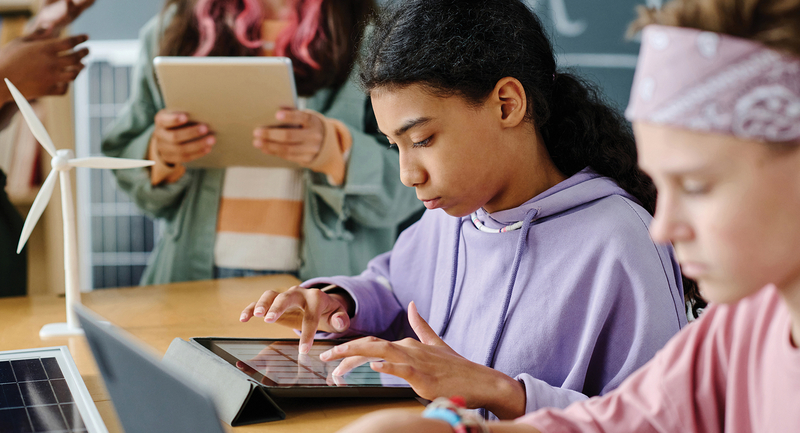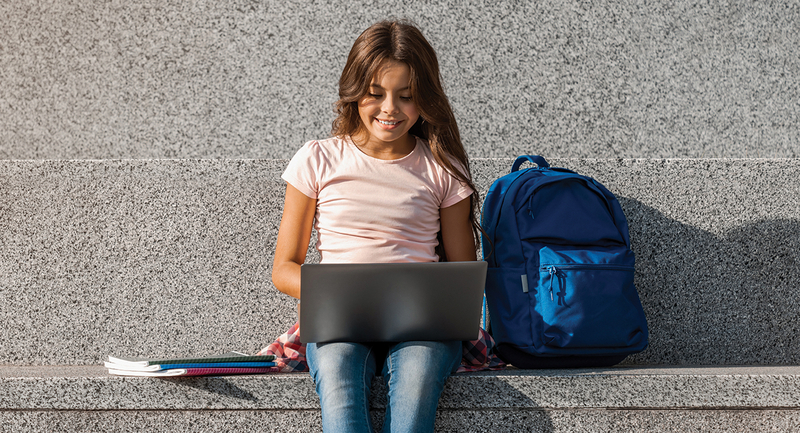Almost 10 years ago, in an article for Scientific American, we explored the following question, which was, at the time, hypothetical: Could an online learning system replace a classroom? In the article, we came to the conclusion that yes, online learning could replace an in-person classroom, but we also argued it most definitely should not. We were classroom teachers at the time, prognosticating about a growing concern among educators concerning the role oftechnology in schools. Indeed, a decade ago, it felt like we were riding a giant wave of new technology initiatives. In a rush to adopt these new tools, many educators were using the tools for the tools’ own sake, not wanting their craft to appear outdated. Others balked at the encroachment of tech tools onto their teaching territory. The questions lingered in the air: Could that technology eventually make the in-person classroom learning experience obsolete? What would that mean for education?
At that time, we predicted that even as technology was improving exponentially, classrooms wouldn’t be replaced. Since then, of course, the world gave us a chance to test our theory. Thanks to the COVID-19 pandemic, we have now lived through a two-year period that caused people to rethink the purpose and method of how we work and connect. Technology became a necessity for so many things, including teaching and learning, but we’ve also seen what is lost when we don’t have access to brick-and-mortar classrooms. And we feel the oxygen leave the room at the idea of going back to online learning, even for a few days.
Our Reasoning in 2012
Ten years ago,we laid out a simple argument for why online learning wouldn’t completely phase out in-person learning. The foundation of our argument was:
Classrooms aren’t just for disseminating information. Students need to learn skills to unpack that information—evaluate it, analyze it, and create their own understandings. To do these things, students need to collaborate with other students and their teachers.
Our society is based more on service and face-to-face—or at least interpersonal—interactions than solitary work. Students need to have the skills to collaborate with others.
The education (of younger students especially) is as much about learning how to be a person in the world as it is about gaining academic knowledge and skills.
Teachers have always been an invaluable resource to students and schools.
Now that the question, Could an online learning system replace a classroom?, is no longer a hypothetical, we can safely say that we agree with the foundations of our argument above. A physical classroom is a necessity for good learning.
Thanks to the COVID-19 pandemic. . . . technology became a necessity for so many things, including teaching and learning, but we’ve also seen what is lost when we don’t have access to brick-and-mortar classrooms.
Our Current (Pandemic-Inspired) Reasoning
As administrators in independent schools in California, we’ve come to see the value of in-person learning in fostering and developing certain SEL skills in students and mitigating the negative effects of challenges such as educator burnout and overuse of technology.
Social-Emotional Skills
Many students wilted during online learning without the social interaction they were used to. This isn’t to say that some kids didn’t enjoy or even thrive academically while engaged in distance learning, but they were the minority. Things that we took for granted before the pandemic—passing people in the hall; saying a brief hello to friends; reading non-verbal communication cues; sharing books, materials, and space; and all of the self-regulatory skill management that goes along with these things—were gone. Students learned in a social vacuum. One mitigating factor was breakout rooms, which allowed students to interact with each other in small groups. But some students were so self-conscious on these virtual platforms that they couldn’t turn on their cameras. And many students knew, deep in their gut, that interacting online was just not natural.
Students who were used to being around peers and trusted adults at school were missing a vital component of their support system—seeing people through a screen, while better than not seeing them at all, is no substitute for being in-person. During the pandemic, many students experienced mental health issues, with self-reports of anxiety and depression doubling. Online school can’t be blamed for all that increase—the pandemic itself brought about other challenges and major concerns that affected mental health—but it cannot be understated how the format of online schooling contributed to the problem. Kinesthetic Opportunities
Students are not meant to sit for eight hours a day. As much as we tried to mitigate students’ amount of time in front of a screen by assigning asynchronous work, it was an impossible task. Students who wanted to connect to their friends would chat or play games online. At the end of the day, students would have a glazed look in their eyes. Physical education was also a challenge on these online learning platforms. For some students, the majority of exercise and movement they experience is in school, and even with the creative exercise and brain break activities that teachers designed, physical activity plummeted during the pandemic. Interpersonal Skills
All the small and big social interactions that students have in a day help them learn how to be in the world with other people. These interactions are not always simple. Teachers, administrators, and other education professionals are there to facilitate student learning in this regard. When an issue comes up between students, teachers can give the students tools to solve the problem and help mediate challenges. Without these opportunities, students remain in their own solipsistic bubble, not being challenged by others. In a physical school, students don’t have an escape hatch; walking away is much harder than turning off your screen.
Access to Technology
All the issues we’ve mentioned so far are, in some ways, challenges for students who have a certain level of privilege. About one in 10 students across the country didn’t even have access to technology, which resulted in learning loss and isolation. As a country, we are still playing catch-up in making sure all students have equal access to technology, which casts a shadow on any consideration of a move to online learning. Burned Out Teachers
We are both administrators in independent schools in California. Supporting our teachers and students during the pandemic was of the highest importance. The events of 2020 and 2021 burnt out educators. The pressures of hybrid classrooms (where teachers had to teach both online and in-person students simultaneously), COVID-19 protocols, health and safety fears, and the lack of normalized connections between colleagues and students were a motivation suck. And while having an online option can be incredibly helpful to fill in gaps with health emergencies, many teachers are not lining up to teach in this format. Unintended Consequences of Online Learning
As administrators, we are deeply aware that students engage with tech differently now than they did before the pandemic. Students figured out early on that they could binge-watch Netflix during class, and teachers had a hard time stopping them. They got used to messaging friends and searching Google with no checks. They have backchannels on Discord, and they are more adept at getting around content blocks. Though students expanded their technology skills during this time and can produce more sophisticated multimedia projects, they also developed the habit of splitting their focus among different digital stimuli. The number of bad tech habits they picked up is too great to list here, and much of the content they were exposed to was beyond teacher and parent control.
Educators, too, engage with technology differently since the pandemic. They have gained incredible technology skills and are eager to share them with students and help guide students with responsible tech use. Even teachers who were tech-averse before the pandemic learned how to creatively engage students in rich learning experiences. Plus, this experience showed teachers how resilient they are, and how, when necessary, they can be flexible and open to change. This new openness to change plays out in teachers’ general attitudes toward their craft, not simply in the realm of technology. And now, teachers are coming back to the classroom, saying “If I did that, I can do anything.”
Can online learning replace the classroom? Here’s our updated, 2022 answer to this 2012 question: No.
When a student is in a classroom, a teacher can see if they are struggling, if they are distracted, if they don’t understand something—and they can offer support in more natural ways. During the pandemic, many teachers would say that the most frustrating part of teaching online was how helpless they felt when a student decided to check out and there was nothing they could do to reach them. In person, there are all different ways that teachers can connect with students who seem to be drifting away—a quick note on a desk, a heart-to-heart talk after class, a knowing look or encouraging smile. These are tools difficult to deploy through a screen.
The gap in in-person learning has also led some students to lose a sense of an awareness of others—even more so than we would expect based on their age and stage. Kids need so much more prompting to clean up after themselves, to take care of their classroom and school community. Teachers need to reteach certain basic community skills that help students to remember to think before they speak, be aware of people around them, take responsibility for their actions, and look out for other members of their communities.
These so-called “soft skills,” along with empathy, self-regulation, and community responsibility, are cornerstones of classroom curricula, and while online learning allows for the delivery of content, there are little to no opportunities for students to practice these other skills in community.
Can online learning replace the classroom? Here’s our updated, 2022 answer to this 2012 question: No. Not if we want students to grow up to care about their community and the world around them and be adept at moving through the world with a modicum of self-awareness.
A Full Education
We are not saying that there isn't a place for technology in the classroom—purposeful tech use can be very valuable. Afterall, you must be literate in tech to succeed in this world. But, as humans, we make meaning from the entire context that we find ourselves in. We experience the world through smell, feeling, touch, and interpersonal chemistry.
We’ve seen the results of exclusively learning online—and for most of our students, it wasn’t sufficient for a full education. We need to lean into all the parts of ourselves that did not thrive during online learning—we need to move, get our students moving, get messy, collaborate, build, create, and bask in the ability to do all of this outside of a screen.
Editor's Note: A version of this article first appeared on MiddleWeb. 








